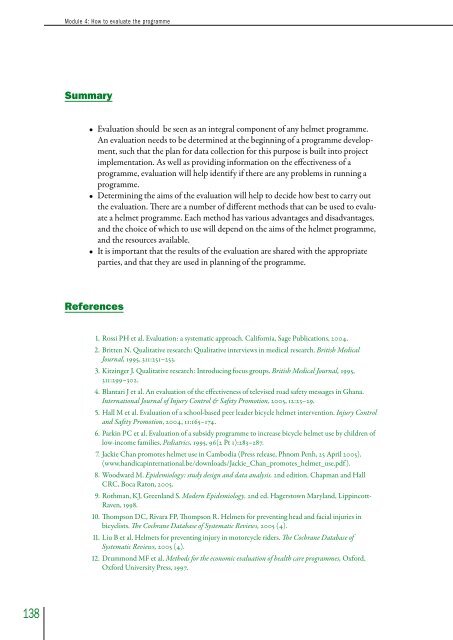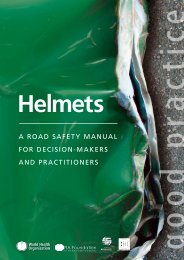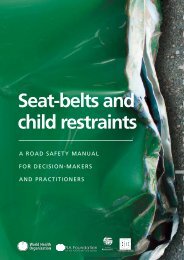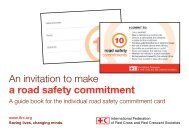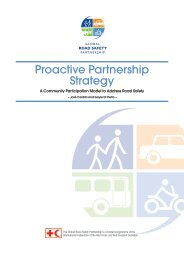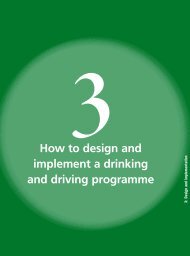How to evaluate the programme - World Health Organization
How to evaluate the programme - World Health Organization
How to evaluate the programme - World Health Organization
You also want an ePaper? Increase the reach of your titles
YUMPU automatically turns print PDFs into web optimized ePapers that Google loves.
Module 4: <strong>How</strong> <strong>to</strong> <strong>evaluate</strong> <strong>the</strong> <strong>programme</strong><br />
Summary<br />
• Evaluation should be seen as an integral component of any helmet <strong>programme</strong>.<br />
An evaluation needs <strong>to</strong> be determined at <strong>the</strong> beginning of a <strong>programme</strong> development,<br />
such that <strong>the</strong> plan for data collection for this purpose is built in<strong>to</strong> project<br />
implementation. As well as providing information on <strong>the</strong> effectiveness of a<br />
<strong>programme</strong>, evaluation will help identify if <strong>the</strong>re are any problems in running a<br />
<strong>programme</strong>.<br />
• Determining <strong>the</strong> aims of <strong>the</strong> evaluation will help <strong>to</strong> decide how best <strong>to</strong> carry out<br />
<strong>the</strong> evaluation. There are a number of different methods that can be used <strong>to</strong> <strong>evaluate</strong><br />
a helmet <strong>programme</strong>. Each method has various advantages and disadvantages,<br />
and <strong>the</strong> choice of which <strong>to</strong> use will depend on <strong>the</strong> aims of <strong>the</strong> helmet <strong>programme</strong>,<br />
and <strong>the</strong> resources available.<br />
• It is important that <strong>the</strong> results of <strong>the</strong> evaluation are shared with <strong>the</strong> appropriate<br />
parties, and that <strong>the</strong>y are used in planning of <strong>the</strong> <strong>programme</strong>.<br />
References<br />
1. Rossi PH et al. Evaluation: a systematic approach. California, Sage Publications, 2004.<br />
2. Britten N. Qualitative research: Qualitative interviews in medical research. British Medical<br />
Journal, 1995, 311:251–253.<br />
3. Kitzinger J. Qualitative research: Introducing focus groups. British Medical Journal, 1995,<br />
311:299–302.<br />
4. Blantari J et al. An evaluation of <strong>the</strong> effectiveness of televised road safety messages in Ghana.<br />
International Journal of Injury Control & Safety Promotion, 2005, 12:23–29.<br />
5. Hall M et al. Evaluation of a school-based peer leader bicycle helmet intervention. Injury Control<br />
and Safety Promotion, 2004, 11:165–174.<br />
6. Parkin PC et al. Evaluation of a subsidy <strong>programme</strong> <strong>to</strong> increase bicycle helmet use by children of<br />
low-income families. Pediatrics, 1995, 96(2 Pt 1):283–287.<br />
7. Jackie Chan promotes helmet use in Cambodia (Press release, Phnom Penh, 25 April 2005).<br />
(www.handicapinternational.be/downloads/Jackie_Chan_promotes_helmet_use.pdf ).<br />
8. Woodward M. Epidemiology: study design and data analysis. 2nd edition. Chapman and Hall<br />
CRC, Boca Ra<strong>to</strong>n, 2005.<br />
9. Rothman, KJ, Greenland S. Modern Epidemiology. 2nd ed. Hagers<strong>to</strong>wn Maryland, Lippincott-<br />
Raven, 1998.<br />
10. Thompson DC, Rivara FP, Thompson R. Helmets for preventing head and facial injuries in<br />
bicyclists. The Cochrane Database of Systematic Reviews, 2005 (4).<br />
11. Liu B et al. Helmets for preventing injury in mo<strong>to</strong>rcycle riders. The Cochrane Database of<br />
Systematic Reviews, 2005 (4).<br />
12. Drummond MF et al. Methods for <strong>the</strong> economic evaluation of health care <strong>programme</strong>s, Oxford,<br />
Oxford University Press, 1997.<br />
138


